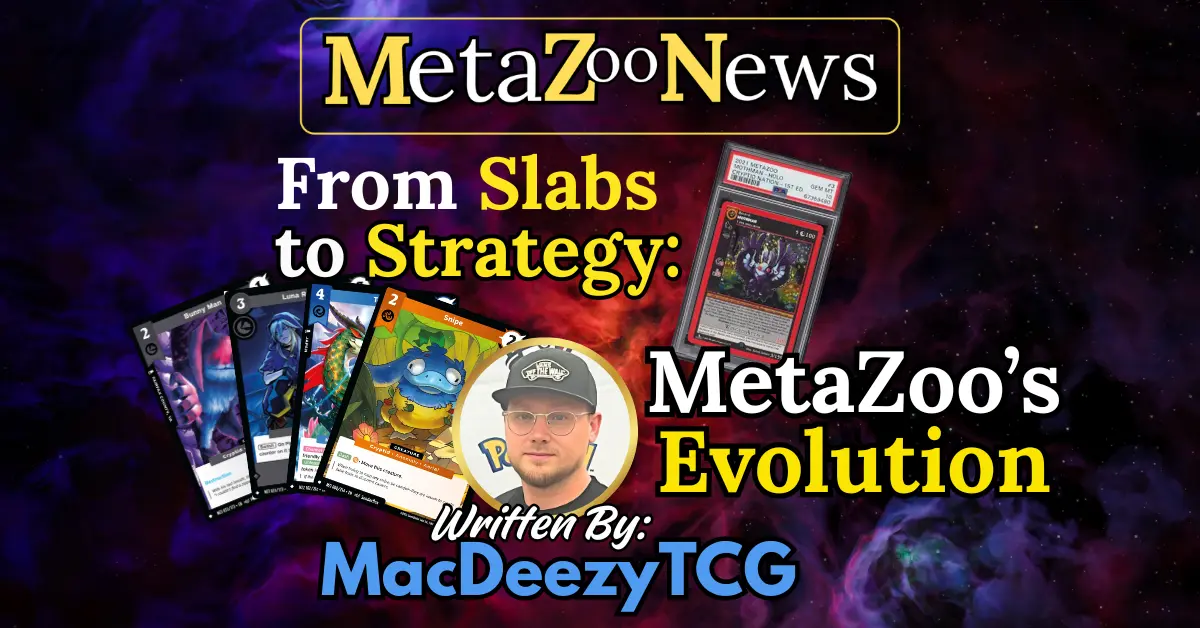Some trading card games (TCGs) begin their life cycles steeped in hype, scarcity, and speculation. Few recent releases illustrate this better than MetaZoo, the cryptid-themed TCG that exploded onto the scene in 2020. Fueled by exclusivity and strikingly nostalgic designs, MetaZoo quickly became a collector’s darling. Slabs were graded before decks were even sleeved, and the game’s competitive side was overshadowed by its collectability.
But today, something new is stirring. The MetaZoo community is shifting, gradually but unmistakably, from a collector-first mindset to a player-focused movement. This evolution deserves a closer look, not just for fans of MetaZoo, but for anyone interested in how TCGs mature.
The Collector Era: Scarcity, Slabs and Speculation
When MetaZoo first launched, its identity was shaped almost entirely by collectors. Limited print runs, exclusive promos, and collaborations with influencers created the perfect storm for demand. The buzz was intoxicating—Discords lit up with talk of PSA 10s, rare variants, and elusive Kickstarter cards.
In this era, the gameplay itself often took a back seat. Many buyers were in it for the chase, the investment potential, or simply the novelty of owning cryptid-inspired cards unlike anything else on the market. The scarcity drove prices sky-high, and for some, that sense of chaos was part of the fun.
Still, there was a downside. For players who wanted to explore the mechanics, access was tough. With so many key cards locked behind steep secondary-market prices, MetaZoo risked becoming more of a collector’s novelty than a sustainable game.
Gameplay Enters the Spotlight
Fast forward to today, and the pendulum is clearly swinging. MetaZoo is no longer just about slabs—it’s about sleeves.
All of this has allowed the meta-game to slowly come to fruition. Balance updates, refined mechanics, and a steadily growing player base are reshaping MetaZoo into something far greater than a collectible curiosity. The upcoming MetaZoo Play Network will add even more structure, rewarding players for participation and giving them reasons to stay engaged and return to events. With these systems in place, MetaZoo is steadily establishing itself as a legitimate TCG—one with a clear focus on its players.
Why This Shift Matters
In the world of trading card games today, every healthy game eventually faces the same test: can it transition from hype-driven collectability to sustainable, community-driven gameplay? For MetaZoo, the answer increasingly looks like yes. This evolution isn’t just cosmetic—it’s foundational.
A healthy TCG needs more than hype. It needs a player base, local scenes, balance, and support. Accessibility brings new players, as lower barriers to entry make it easier for beginners to jump in. Fun and engaging rule sets attract interest, with MetaZoo’s approachable yet unique mechanics pulling in newcomers while keeping competitive players challenged. Competitive play builds longevity, as a strong meta-game ensures veterans remain engaged and invested. Finally, balance fosters trust—when the game feels fair and skill-based, the community as a whole thrives.
By leaning into gameplay, MetaZoo is proving it’s more than a speculative flash in the pan—it’s a game with real staying power.
Appreciating Both Worlds
t’s important to recognize that the so-called collector era wasn’t a misstep—it was a foundation. Without the initial hype, limited print runs, and collector buzz, MetaZoo would never have gained the visibility or momentum it needed to grow. Those early drops created a spectacle that drew in people who might never have touched a trading card game otherwise.
For many, that era was thrilling. Hunting for rare pulls, chasing down exclusive promos, and seeing cards pop up in slabs on auction sites gave the community a sense of urgency and energy. Collectors helped fund the game’s early success, while influencers and content creators amplified its reach. That initial chaos might not have been sustainable long-term, but it gave MetaZoo the spark it needed to survive in an incredibly competitive TCG landscape.
Now, the game’s evolution isn’t a rejection of that beginning—it’s the natural next step. Collectors still have their place in the community, and exclusive chase cards will likely always be part of MetaZoo’s identity. But the growing emphasis on gameplay ensures that the ecosystem is healthier, more balanced, and ultimately more sustainable. Organized play, prize support, and accessible decks give players new reasons to stick around, while collectors still have unique promos, rare variants, and stamped cards to chase.
Conclusion: Building the Future of MetaZoo
MetaZoo’s journey from a collector-focused craze to a developing competitive scene shows just how much potential the game has. The early years were about visibility, exclusivity, and spectacle—without that foundation, the game may never have taken off. But now, its future depends on building systems that keep players engaged long after the hype fades.
To continue growing the player side, MetaZoo can take several important steps:
MetaZoo doesn’t have to choose between collectors and players—it can thrive by serving both. The collector energy will always be part of its DNA, but it’s the focus on gameplay, balance, and community that will determine its legacy.
- MacDeezyTCG


